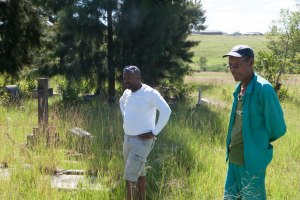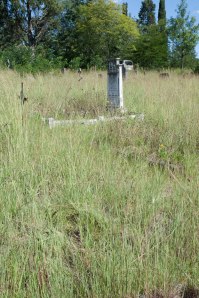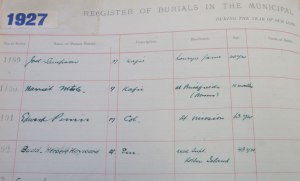February 2012.
My son was going on a school cricket tour from UK to South Africa and I decided to join him. Spending the first week in Cape Town watching cricket in the hot South African summer was a treat as the sleet covered England back home. After the first week, I set out on my adventure – to find Herbert Hayward Budd’s grave.
HH Budd is a great uncle. He died very suddenly in 1927. At the time he was the Medical Superintendent on Robben Island which in those days was being used as a leper colony. His wife Lil and young son Billy lived with him on the Island.
He was working with Lepers on the island and in April 1927 visited the Emjanyana Leper colony which is in the Eastern Cape (some 700 miles distant from Robben Island). Whilst there he very suddenly contracted pneumonia and following a short period in the nearby Umtata general hospital, died. As was common practice he was buried where he died in Umtata (now called Mthatha).
I had worked this much out from my Family History research, but I did not know where ‘The Doc’ was buried. I knew that Lil and Billy had never visited his grave before returning home to England in 1928. Could I be the first family member ever to visit the grave?
Boarding a flight from Cape Town to Johannesburg, and then a very small propeller plane from Jo’burg to Mthatha, I became increasingly nervous. Having been in touch with a voluntary organisation in South Africa which records gravestones, they had advised that no grave was known in Mthatha, but of more concern, that the town would be dangerous to visit alone as a white person.
My itinerary allowed me only 24 hours in town. Any attempts to contact the municipal offices had failed, with phones just ringing off the hook. I had booked a room in the only hotel I could find…and that was all I had to work with.
Speaking to the Hotel clerk the day before, I had a telephone number of a local cab driver who was trusted by the hotel staff. He picked me up at the tiny airport building. He was to be my guide and saviour over the next 24 hours.
On the way into the town (as we travelled through sprawling wicker hut encampments on each side of the road) I tried to find out as much as I could about the environment. Telling my story, Sibongiseni, my driver, cheerfully told me about his life as a cab-driver, trying to support his family. Our interests aligned – hiring him for 24 hours would give me a chance to get about the town, probably safely, and with some local knowledge. In return, I would pay my new friend a decent sum which would no doubt be very welcome. Dropping me off at the Hotel (where I was effectively imprisoned, being told that it was far too dangerous to go out alone), we agreed that he would pick me up the next morning.
Right on time, his smart VW taxi-van pulled up outside the hotel. First stop was to be Mthatha cathedral – to see if any burial records were to be found. Very soon I was speaking to the Bishop of the diocese, who confessed that any records they might have would be hard to find and probably incomplete. He advised going to the Municipal offices where cemetery records might still exist. By good fortune, Sibongiseni had a niece who worked there. Driving across Mthatha he tooted his horn constantly, waving to people he knew and shouting animatedly out of the driver’s window in his native isiXohsa – I had managed to team up with one of the most connected people in town.
Arriving at the bustling Municipal offices, we quickly found ourselves in a tiny office where a town official was happy to see me. He was responsible for the Municipal parks, which included the cemeteries. I told him my story and he offered to help. When I explained that I was booked on a flight to Jo’burg at 4pm that day, he laughed…South African administration does not move quickly. Giving me a warm, toothy smile, he nonetheless said he’d do what he could. Within 5 minutes a dusty ledger book was open on his desk. Turning to the page for 1927, the burial record for Herbert Hayward Budd was quickly located. I couldn’t believe my luck. But with the good news came bad. Although the location of the grave was set out, he explained that the ‘white graves’ from the period were in a very overgrown and untended part of the cemetery. Only one person knew his way around the graves – him. He had a day full of meetings, but he would meet me at 2pm and we would go over to the site together. Returning to my hotel to wait the 3 hours until our next meeting, my heart was in my mouth. We were so close, but I had only one hour from the time we would all meet again to find the site before I had to leave for the airport.
Sibongiseni arrived late, smiling and relaxed. I did not share his calm demeanour. We went to the Municipal offices where my guide was waiting. This time the news was not so good. He had an urgent meeting to attend and could not take me to the grave. Playing with my emotions and seeing my disappointment, he let me take in the news. Then, with a big smile, he said that he’d driven over to the cemetery during his lunch hour, taken the cemetery worker (aka grave digger) with him…and they had found the grave. It was unmarked, he explained, but could be found by locating a neighbouring gravestone. He had marked the mound (which was all that remained of HH Budd’s grave) with some knotted grass. The cemetery worker would be waiting for me and would lead us to the grave. As he said goodbye, he made me promise that I would raise a headstone for HH Budd, ‘to show that he had not been forgotten’. With tears in my eyes I left his office, overwhelmed by the kindness and support he had shown a total stranger. It was nearly 2.30 pm when Sibongiseni and I reached the cemetery.
Picking up the cemetery worker, who spoke no English, we made our way across the tumbledown modern grave sites to the much older, colonial graves. Our cemetery worker quickly became disorientated and could not find the grave. With time against us we were on our own and I frantically walked up and down the rows of untended, tipping gravestones trying to find HH Budd’s neighbour, which would lead me to him. Eventually some order to the site emerged and I was able to work chronologically towards the graves dating from the 1920s.
And then I found him.
Right next to the cross which had been pointed out, a small rise in the ground, overgrown, untended, but with 2 small knots of grass which marked the spot where HH Budd was buried. I had never met him, knew of him only through research, but I shed a tear for this man, who had lain there under hot African sun since 1927 and had never been visited by anyone from his family.
Shattering this moment, a noise from a crowd of school children brought me back to the present. A nearby school yard sprawled onto the edge of the cemetery and shouting from a small group of teenagers indicated something untoward going on. Suddenly 2 gunshots pierced the air and 2 gangly men (one brandishing a pistol above his head as if to warn off anyone in pursuit) ran from the crowd and across the cemetery. Carrying the bag they had stolen,they passed close by, but were more intent on escaping than acknowledging us. I looked on as if I was watching a scene from a movie. Sibongiseni shrugged and explained wearily that shootings and muggings were part of everyday life in Mthatha.
Recovering my composure, I snapped a few pictures, paid a tip to the cemetery worker and then raced to the Airport. As I sat in the tiny aeroplane as it whirred over the vast uninhabited interior of South Africa, I could hardly believe what had happened in the previous 24 hours. Another 24 hours later, I was at home in Wimbledon, back in the sleet and greyness of winter. What had happened in a small town in the Eastern Cape seemed like a dream.



HH Budd has been found again. And one day I will return to raise that headstone…so that he is not forgotten. Update: it is done, see my post here.
I am so glad that I played a tiny part in this wonderful story of discovery and that you found Africa a friendly place!
Liz…thank you so much for your help!
Glad you made it. Let me know when you go back to raise the headstone.
I shall! In fact, I think it will be later this year…making some plans now and I’ll be sure to post here if I make it.
Lovely story. I came across it while researching my mother’s childhood in the Transkei – Qumbu to be exact.